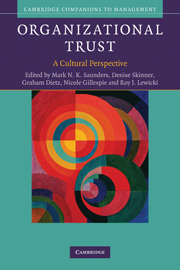Book contents
- Frontmatter
- Contents
- List of figures
- List of tables
- Note on editors
- Note on contributors
- Foreword
- Editors' acknowledgements
- Part I The conceptual challenge of researching trust across different ‘cultural spheres’
- 1 Unravelling the complexities of trust and culture
- 2 Trust differences across national–societal cultures: much to do, or much ado about nothing?
- 3 Towards a context-sensitive approach to researching trust in inter-organizational relationships
- 4 Making sense of trust across cultural contexts
- Part II Trust across different ‘cultural spheres’: inter-organizational studies
- Part III Trust across different ‘cultural spheres’: intra-organizational studies
- Part IV Conclusions and ways forward
- Index
- References
1 - Unravelling the complexities of trust and culture
Published online by Cambridge University Press: 05 June 2012
- Frontmatter
- Contents
- List of figures
- List of tables
- Note on editors
- Note on contributors
- Foreword
- Editors' acknowledgements
- Part I The conceptual challenge of researching trust across different ‘cultural spheres’
- 1 Unravelling the complexities of trust and culture
- 2 Trust differences across national–societal cultures: much to do, or much ado about nothing?
- 3 Towards a context-sensitive approach to researching trust in inter-organizational relationships
- 4 Making sense of trust across cultural contexts
- Part II Trust across different ‘cultural spheres’: inter-organizational studies
- Part III Trust across different ‘cultural spheres’: intra-organizational studies
- Part IV Conclusions and ways forward
- Index
- References
Summary
Introduction
Badri is an Iranian businesswoman representing her firm in first-round negotiations with a new alliance partner from Munich, Germany. When she enters the room, her counterpart from the German firm, Johann, reaches out his hand for her to shake as a first gesture of goodwill. Badri hesitates, but takes Johann's hand briefly, shakes it once, smiling the whole time. Then she sits down. Johann is impressed by her apparent openness; for him, this bodes well for the talks ahead. Behind him, a few colleagues wince at his indiscretion, but are relieved when it appears he has got away with it. Behind her, Badri's male colleagues from Iran are shocked. Some are disgusted. For women to touch unfamiliar men is neither customary nor appropriate in their culture. But Badri has studied and worked in the States for several years and, though she finds such incidents uncomfortable, she has learned to ‘switch’ between styles of working when required. Plus, for her, the priorities of her employer mean that nurturing a solid, trusting relationship with their German partner is of paramount importance.
Sean and Nils are elected employee representatives sitting on the European Works Council of the Anglo–Dutch steel firm, Corus, for whom they both work. Nils is Dutch and works in his native Holland; Sean is Irish but works in a smelting works in England. They are both union members (though in different unions), both Corus employees, and both engineers.
- Type
- Chapter
- Information
- Organizational TrustA Cultural Perspective, pp. 3 - 41Publisher: Cambridge University PressPrint publication year: 2010
References
- 53
- Cited by

